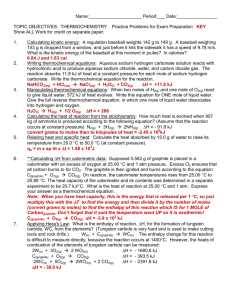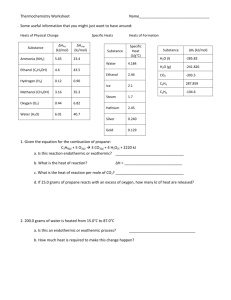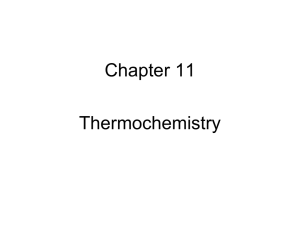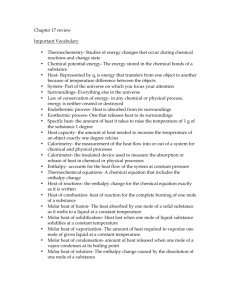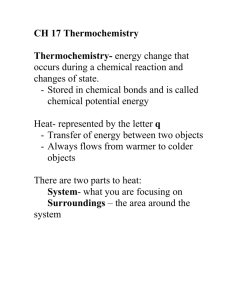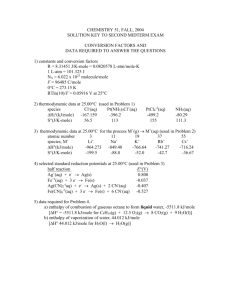Lecture 15
advertisement
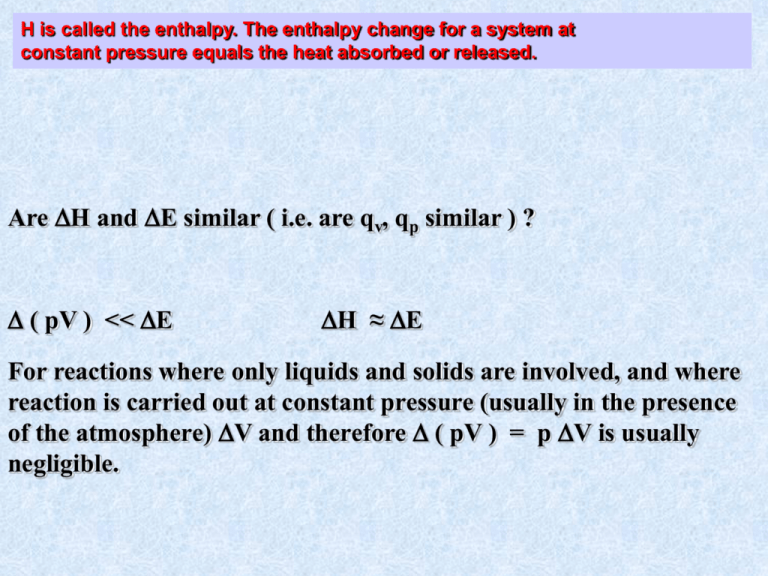
H is called the enthalpy. The enthalpy change for a system at constant pressure equals the heat absorbed or released. Are H and E similar ( i.e. are qv, qp similar ) ? ( pV ) << E H ≈ E For reactions where only liquids and solids are involved, and where reaction is carried out at constant pressure (usually in the presence of the atmosphere) V and therefore ( pV ) = p V is usually negligible. N2 + O2 2NO n = 0 ( pV ) = 0 at const T, H= E N2 + 3 H2 2 NH3 n = -2 (pV) = -2RT H = E + nRT for reactions of ideal gases H = 2 Hfo ( NH3 ) = 2 ( -46,110 ) = -92,220 joules Example : Convert 1 mole of liquid H2O at 100o C into 1 mole of H2O vapor at 100oC and p = 1 atm. H = 44,013.6 joules/mole What is E? H = E + ( pV ) = E + p V (const p) 1 mole H2O = 18 gm; volume 1 gm of H2O at 100oC is 1.04 mL/gm vi = 18 ( 1.04 ) = 18.72 mL vf = nRT / p assume ideal gas v = 30,586 - 19 = 30,567 mL = 30.57 liters .082 L-atm = 8.314 joules 101.4 joules/L-atm E = H - p V E = 44013.6 joules/mole - 3099.5 joules/mole General Definitions of heat capacities (for 1 mole of gas): dQ (sub P means take derivative at constant P) cp dT P dQ (sub V means take derivative at constant V) cV dT V Substitute dQ = dE + pdV= dE - dw (1st Law) RT 3 V Remember E RT (1 mole gas) P 2 3 PR dT R = (3/2)R + R = (5/2)R 2 P dTP Bonus * Bonus * Bonus * Bonus * Bonus * Bonus Thermochemistry: Can measure H directly by making a laboratory determination of qp. Want to set up a table of enthalpy changes for chemical reactions Standard Enthalpy Change H for a system Standard State of a Substance That form of the substance which is most stable at a pressure of 1 atm and T = 298 K Examples Carbon : at 1 atm, 25C, Stand. St. is graphite (not diamond or coal) Bromine : 1 atm, 25 C Std. St. is liquid Bromine For a reaction: C ( graphite ) + O2 ( g ) CO2 ( g ) measure qp in lab (Heat released when burn graphite at const p) This means evolve 393.52 kjoules of heat in converting 1 mole C graphite, 1 mole O2 gas, into 1 mole CO2 gas at 1 atm and 298 K. Can also burn CO in lab to produce CO2: Hess' Law of Constant Heat Summation Heat evolved or absorbed at constant pressure for any chemical change is the same regardless of the path by which the change occurs. C (graphite) + O2 (g) CO (g) + (1/2) O2 (g) Can’t measure in the lab. (Always get a little CO2) QuickTime™ and a Video decompressor are needed to see this picture. Enthalpy's of Formation Standard Enthalpy of formation is ∆H for a reaction where a pure compound is formed from its elements with all substances in their standard states ( 25 C ) H2 (g) + 1/2 O2 (g) = H2O(l) ∆Hf ( H2O ) = -285.8 kjoules Enthalpy of formation of elements in their standard state is defined to be zero: Why are ∆Hf useful? Suppose we want to know ∆H for the reaction: 1 2 CH3COOH = 2 C (s) + 2 H2 (g) + O2 (g) = CH4 (g) + CO2 2 : ∆H = + ∆Hf ( CH4 ) + ∆Hf ( CO2 ) because ∆H is independent of path. In principle can always accomplish a chemical transformation by following a path which 1st decomposes reactants into elements then reforms product.

